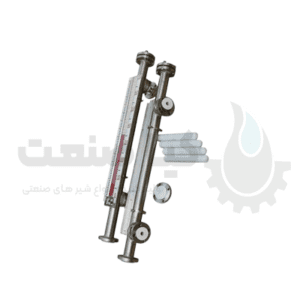Level Gauge
Showing the single result
Level Gauge
Level Gauge is a device used to measure the level of a liquid or the amount of material in a container or storage tank.
It is commonly used in industrial and commercial applications where accurate liquid level measurement is critical for process monitoring and control.
Level gauges can be designed to work with different types of fluids such as water, oil, chemicals or gases and are available in different configurations and technologies.
The main purpose of a level gauge is to provide a visual and real-time indication of the level of liquid or material in a container or tank.
This information is essential to maintain optimal performance, prevent overflows or underflows, manage inventories, and ensure safety.
Level gauges can be externally mounted or built directly into the tank or storage tank.
Reflex level gauges
Level reflex gauges are instruments used to measure the level of liquids in tanks or containers. They are commonly used in industries such as oil and gas, petrochemical, and power generation.
These level gauges work using the principle of light reflection.
They consist of a transparent glass tube with a prism on the outside and a liquid chamber inside.
When the liquid level is below the gauge, the prisms appear bright, and when the liquid level is above the gauge, the prisms appear dark.
The change in the appearance of the prisms is due to the different refractive index of liquid and vapor or gas above the liquid level
Bright prisms indicate the presence of a gas or vapor, while dark prisms indicate the presence of a liquid.
There are two types of reflex level meters: single segment and multi-segment.
In single-section reflex level gauges, one section of the glass tube is intended for measuring liquid, while in multi-section reflex level gauges, there are several sections for measuring different levels or different liquids.
Reflex level gauges are often preferred over other types of level gauges because they provide a clear indication of the liquid level.
They are easy to read and relatively inexpensive.
However, they have limitations, such as the potential for the glass to become cloudy due to deposits or strongly colored or opaque liquid.
In general, reflex level gauges are widely used in industrial applications where accurate and reliable liquid level measurement is required.
Transparent level gauges
Levels are transparent gauges, also known as sight glasses or level indicators.
are devices that are used to visually monitor the liquid or gas level in a tank or container.
They consist of a clear tube or sight glass that provides a direct view of the fluid surface.
These gauges usually consist of a tubular glass or plastic sight glass that is attached to the side of the tank or container.
The transparent part of the gauge allows operators to visually check the fluid level
Some clear gauges also have markings or scales that indicate specific levels or measurements.
Transparent level gauges are a popular choice in industries such as chemical processing, oil and gas, power generation, and water treatment, where visual monitoring and control of fluid levels is important.
They provide a simple and reliable method of surface measurement that does not require electricity or the use of additional sensors or instruments.
However, it is important to note that clear gauges may not be suitable for all applications. They mayتوسط Limiting factors such as high temperature, corrosive substances or pressure conditions.
In such cases, alternative level measurement technologies such as magnetic level gauges or ultrasonic level sensors may be used.
Bi-color level gauges
Two-color level gauges are used to evaluate the liquid level inside the tank or container.
They consist of a transparent tube or glass case with two different colored parts.
Color separation shows the location of the liquid surface
One section of the tube is usually red or another bright color, while the other section is white or a contrasting color.
The red part represents the surface of the liquid, while the white part represents the void or gas phase above the liquid.
The liquid inside the tube moves up and down based on the level in the tank.
As the liquid level rises, the red area expands upwards, visually indicating the rising level.
Similarly, as the liquid level decreases, the red area decreases, indicating the decrease in level.
Two-color level gauges are commonly used in industries such as oil and gas, chemical processing, water treatment, and power generation. They provide a simple and intuitive visual indication of the liquid level, making them easy to read and monitor.
Magnetic level gauges
A magnetic level gauge is a type of level measuring instrument that uses the principle of magnetic attraction to measure the liquid level inside a tank or container. which consists of a float containing a permanent magnet and a scale attached to the outside of the tank.
The float moves up and down with the liquid level and the magnet inside the float aligns itself with the magnetic field of the associated level indicator.
As the float moves, a scale outside the tank provides a visual indication of the liquid level.
Magnetic level gauges have several advantages over other types of surface measuring devices
They are very reliable and accurate because there are no mechanical parts that can wear or break.
They are also suitable for a wide range of liquids, including aggressive or hazardous liquids, as there is no direct contact between the liquid and the gauge.
In addition, magnetic level gauges are easy to install and require minimal maintenance.
They can be used in high pressure and high temperature applications and can also be combined with other devices such as switches or transmitters to provide additional performance.
In general, magnetic level gauges are a popular choice for level measurement in various industries including petrochemical, oil and gas, Pharmaceuticals and food and beverages.
Level gauges come in different sizes and are used to measure the level of liquid or bulk materials in tanks, ships or pipelines.
The size of the level of the gauges depends on the application, the size of the tank and the accuracy of the desired surface measurement. Some of the common sizes of level gauges are:
1 inch: These smaller level gauges are often used in smaller tanks or vessels with lower volume capacity. And they are suitable for applications where high measurement accuracy is not critical.
2 inch: These medium level gauges are usually used in tanks or containers with medium volume capacities. They offer better accuracy compared to smaller gauges and can be used in a wide range of industrial applications.
3 inch: These larger level gauges are suitable for larger tanks or containers with higher volume capacities. They provide more accurate surface measurements and are commonly used in critical industrial processes where accuracy is critical.
Apart from the size, level gauges in different types or designs such as reflex level gauge, magnetic level gauge, reflex level gauge, There are two-color gauges, etc. Each type is suitable for different applications and has its own characteristics and advantages.
In general, the choice of level gauge size depends on factors such as tank size, accuracy required, type of material being measured and cost considerations. It depends.
Choosing the right size and type of level gauge is important to ensure accurate and reliable level measurement in industrial processes.


